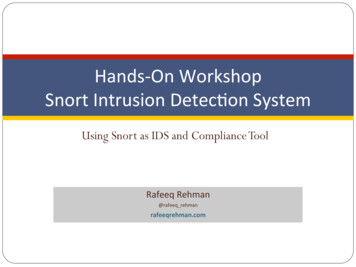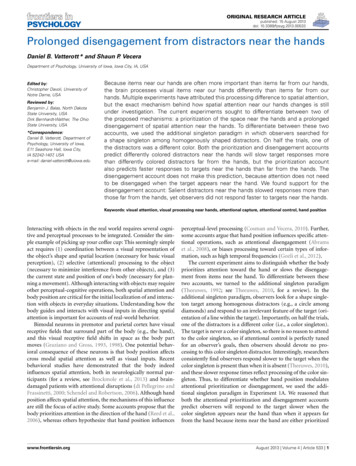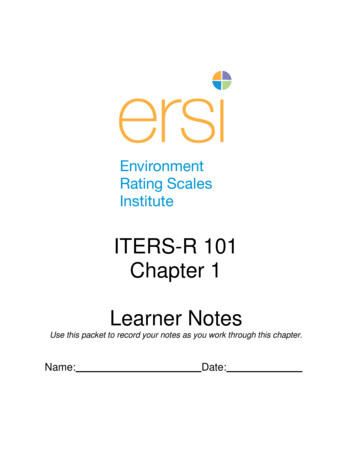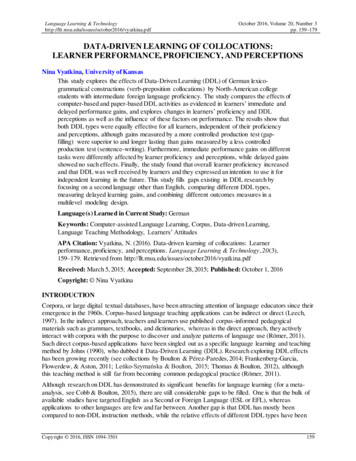
Transcription
Hands- ‐OnWorkshopSnortIntrusionDetec7onSystemUsing Snort as IDS and Compliance ToolRafeeqRehman@rafeeq rehmanrafeeqrehman.com
Module 1 - Introduction
Module Outline Software List for the course Pre-Requisites Reference Material Intrusion Detection and Intrusion Prevention Systems Types of Intrusion Detection Systems (IDS) Rule and Anomaly based Intrusion Detection Methods Inline and Passive Mode IDS Placement of IDS in Network3 Copyright 2011-2013 - Rafeeq RehmanJanuary 27, 2013
Software/Manual for This Workshop Following is a high level software list for this workshop: Linux Operating System Snort Snort Rules Snort DAQ Library Compilers and different utilities Libraries for linking with snort binaries Snort Manual4 Copyright 2011-2013 - Rafeeq RehmanJanuary 27, 2013
Pre-Requisites Familiarity with Linux Operating Systems is necessary.You don’tneed to be expert in Linux but need to know simple commandsto operate Linux. Linux file system structure A laptop/desktop with Virtual Box installed to run Linux.Youwill receive a virtual machine Access to the Internet5 Copyright 2011-2013 - Rafeeq RehmanJanuary 27, 2013
Reference Material Snort – www.snort.org Snort Rules Sourcefire – http://www.snort.org/snort-rules/ Emerging Threats – http://rules.emergingthreats.net OSSEC – http://www.ossec.net OSSEC Reference Manual – http://www.ossec.net/doc/ Splunk – www.splunk.com Splunk Base – http://splunk-base.splunk.com/apps/ Splunk OSSEC -for-ossecsplunk-v4-version Splunk Snort -for-snortsplunk-4x6 Copyright 2011-2013 - Rafeeq RehmanJanuary 27, 2013
Some Initial Thoughts Snort is a tool, not a solution to a problem. It is up to a user how touse this tool. Don’t look for something specific, just learn how to use the tool. If youare told to look for specific, you don’t see anything else! Ask questions: How do you know that? You are not going to be expert after this training. The objective is toget you started on a journey. ASK QUESTIONS! If I don’t know the answer, I will find it for you. Itwill help me get better.7 Copyright 2011-2013 - Rafeeq RehmanJanuary 27, 2013
What is an IDS and IPS? Intrusion Detection System will create alerts Intrusion Prevention System will stop activity based upon somecriteria Network Intrusion Detection System - Checks for specificactivities or anomalies at the network layer and Types of IDS Host Based (HIDS) Network Based (NIDS) Method of Detection Rule Based Anomaly Based Hybrid Snort is NIDS but can be used “inline” to work as IPS8 Copyright 2011-2013 - Rafeeq RehmanJanuary 27, 2013
Inline and Passive IDS/IPS9 Copyright 2011-2013 - Rafeeq RehmanJanuary 27, 2013
Placement of NIDS10 Copyright 2011-2013 - Rafeeq RehmanJanuary 27, 2013
Enterprise IDS with Multiple Sensors11 Copyright 2011-2013 - Rafeeq RehmanJanuary 27, 2013
Host Based IDS Detect host based attacks System file changes Registry changes Log file parsing File Integrity Checks Alerting Rules Centralized Management Snort is not a host-based IDS. It is better if you use somethinglike OSSEC or AIDE12 Copyright 2011-2013 - Rafeeq RehmanJanuary 27, 2013
High Level Snort Architecture13 Copyright 2011-2013 - Rafeeq RehmanJanuary 27, 2013
Introduction to Snort
Tasks for Getting Snort Up1. Installation Source Code RPM Yum (or other tools)2. Installing Snort rules3. Initial Configuration Mainly configuring snort.conf file4. Managing alerts15 Copyright 2011-2013 - Rafeeq RehmanJanuary 27, 2013
Snort Preprocessors Preprocessors handle data before it is handed over to detection engineand after packet decoding. Major preprocessors include: Frag 3 - IP defragmentation Streams 5 - TCP stream reassembly sfPortscan - Detect reconnaissance RPC Decode Performance Monitor HTTP Inspect - Find and normalize fields SMTP - Find SMTP commands and responses FTP and Telnet Preprocessors - FTP/Telnet commands and responses SSH - Detects SSH protocol exploits DNS - Detects DNS exploits by looking and DNS queries ARP Spoof detection You can write your own preprocessors16 Copyright 2011-2013 - Rafeeq RehmanJanuary 27, 2013
Configuring Preprocessors Preprocessors are configured through Snort configuration filesnort.conf----------------------preprocessor sensitive data: alert threshold 25 \mask output \ssn file ssn groups Jan10.csv Preprocessors can take files as input. An example is reputationpreprocessor that can read black list IP address file.17 Copyright 2011-2013 - Rafeeq RehmanJanuary 27, 2013
Logging and Alerting Difference of Log and Alert Files/Destinations Writing rules for logging and alerting Logging and Alerting You can only log, alert, or both Logging and Alerting Mechanisms Storing Snort data in files using Full and Fast alerting Syslog Unix Socket Database CSV TCP dump logging You can create your own output modules18 Copyright 2011-2013 - Rafeeq RehmanJanuary 27, 2013
Configuring Output Modules Output modules are configured through snort.conf file Setting log limits for filesoutput alert syslog: host 192.168.2.10:514, facility priority options output alert syslog: host 192.168.2.10:514, log auth log alertlog ndelay19 Copyright 2011-2013 - Rafeeq RehmanJanuary 27, 2013
Output Modules Syslog Alert and Log to file CSV Database Tcpdump20 Copyright 2011-2013 - Rafeeq RehmanJanuary 27, 2013
Snort Directory Structure The bin directory The lib directory The etc directory Rules directories21 Copyright 2011-2013 - Rafeeq RehmanJanuary 27, 2013
Sensor Directory Structure All directories are under /opt/snort directory. - - - - - - - - --22adminbinetclibpreproc rulesrulesshareso rulessrc Copyright 2011-2013 - Rafeeq RehmanJanuary 27, 2013
Logs and Alerts directory Logs and alerts go under logs directory but can be configured to anyplace/opt/snort - - - - - - --etclogs -- 192.168.144.154 -- snortpreproc rulesrulesscriptsso rulestemp Each sensor has a directory under /opt/snort/logs directory23 Copyright 2011-2013 - Rafeeq RehmanJanuary 27, 2013
Summary24 Copyright 2011-2013 - Rafeeq RehmanJanuary 27, 2013
Exercise25 Copyright 2011-2013 - Rafeeq RehmanJanuary 27, 2013
Snort Installation
Module Outline The installation can be done in two basic ways: Using Snort rpm which are pre-built packages From the source code RPM method is easy Advanced users should use source to compile the options theyneed. Compiling from source code has a number of benefits: You can include the options that you want You can choose the location of installation files The pre-installed Snort versions usually lack many features Installing from source code needs more knowledge of Linux We will cover both methods.27 Copyright 2011-2013 - Rafeeq RehmanJanuary 27, 2013
Steps for Installing Snort from Source Code Download Snort and DAQ Libraries Unpack and Install DAQ Use tar command to unpack Use configure to prepare for compilation Use make; make install to compile and install DAQ Install Dependencies (libdnet, pcre, etc) Unpack and Install Snort Use tar command to unpack Use configure command to prepare for installation (discussed onnext slide) Use make; make install to install Snort. Install Snort rules files Edit snort.conf file28 Copyright 2011-2013 - Rafeeq RehmanJanuary 27, 2013
Compiling From Source Code Download source code file snort-2.9.4.tar.gz Download daq-2.0.0.tar.gz Install DAQ library (tar zxvf daq-2.0.0.tar.gz, configure, make, makeinstall) Unpack source code tar -zxvf snort-2.9.4.tar.gz which will createdirectory snort-2.9.4 Go to directory using command “cd snort-2.9.4” Run configure command: “./configure --prefix /opt/snort --enablenormalizer --enable-reload --enable-dynamicplugin --enable-zlib -enable-gre --enable-mpls --enable-targetbased --enable-ppm --enableperfprofiling --enable-profile” Most probably this command will fail due to dependencies.29 Copyright 2011-2013 - Rafeeq RehmanJanuary 27, 2013
Compiling From Source Code (Continued) You will need to install at least the following libraries and header files: libpcap (pcap-devel) pcre (pcre-devel libnet libdnet ( http://code.google.com/p/libdnet/) You may also need to have following tools if you have not alreadyinstalled. The configure command will show you what you need toinstall bison flex or lex Continue running configure command until you succeed. Each timeyou will install any missing software needed for compilation.30 Copyright 2011-2013 - Rafeeq RehmanJanuary 27, 2013
Compiling From Source Code (Continued) After configure script succeeds, run “make” command. Once “make” is complete, run “make install” command The above step will create /opt/snort directory (from --prefix 31command line parameter of configure script).Download snort rules file from snort.org after registering. This file issnortrules-snapshot-2941.tar.gzRun “tar zxvf snortrules-snapshot-2941.tar.gz” command that will extractrules by creating multiple directories. Copy these directories in /opt/snort directory.Edit /opt/snort/etc/snort.conf file to configure location of rule files andother directories (set location of different files and directories)Create log directory using command “mkdir /opt/snort/logs”Run “/opt/snort/bin/snort -c /opt/snort/etc/snort.conf -l /opt/snort/logs”If everything goes well, you will be running a working snort now. Copyright 2011-2013 - Rafeeq RehmanJanuary 27, 2013
A Word About Snort Rules Snort Rules filenames contain Snort version. Download the file that is relevant to your Snort installation. You have to register to download rules.32 Copyright 2011-2013 - Rafeeq RehmanJanuary 27, 2013
Starting and Stopping Snort Testing Snort “/opt/snort/bin/snort –dev –i eth0” The above command will run snort in packet dump mode. Run Snort using command “/opt/snort/bin/snort -c /opt/snort/etc/snort.conf -l /opt/snort/logs” The -c flag is used to specify configuration file The -l flag is used to specify location of log files If location of log files are not specified, the logs go to /var/log/snortdirectory by default.You need to create this directory manually. If you want Snort to listen on a specific adapter, you need to use -i command line switch. An example would be -i eth1 (or -i p2p1)33 Copyright 2011-2013 - Rafeeq RehmanJanuary 27, 2013
Gotchas Log Directory Snort log directory may not exist and you may have to create it. Default log directory is /var/log/snort You can use a different log directory using command line switch orsnort.conf file. Ethernet Device Name The Ethernet device name may differ on different Linux versions/distributions. To check device name, run ifconfig command. On CentOS, RedHat, Old Fedora, the device name may be eth0 oreth1. On new Fedora distributions, it may be p2p1 etc. Initially disable reputation preprocessor in snort.conf file to makeSnort work.34 Copyright 2011-2013 - Rafeeq RehmanJanuary 27, 2013
Automatic Start and Stop Create a script /etc/init.d/snort Set up run levels and order of start/stop Use chkconfig --add snort to create links in sequencer directories Use /etc/init.d/snort start to start Snort Use /etc/init.d/snort stop to stop Snort Use “ps -ef grep snort” to command to check if Snort is running. Use “tail -f /opt/snort/logs/alerts” to see new alerts in real time35 Copyright 2011-2013 - Rafeeq RehmanJanuary 27, 2013
IP Reputation – Black and White Lists Reputation Plugin Download files from emerging threats: 2.9.0/rules/rbn-ips.txt 2.9.0/rules/rbn-malvertisers-ips.txt 2.9.0/rules/compromised-ips.txt 2.9.0/rules/emerging-compromised.rules36 Copyright 2011-2013 - Rafeeq RehmanJanuary 27, 2013
Summary Installing Snort using: RPM From Source Code Copying Rules Files Editing snort.conf file Snort startup and Shutdown Automatic startup/shutdown scripts37 Copyright 2011-2013 - Rafeeq RehmanJanuary 27, 2013
Exercise Build Snort and Run it.38 Copyright 2011-2013 - Rafeeq RehmanJanuary 27, 2013
39 Copyright 2011-2013 - Rafeeq RehmanJanuary 27, 2013
Installing Snort Rules
Summary Downloading Sourcefire Snort Rules and Installation Editing snort.conf to select different types of rules Creating local rules41 Copyright 2011-2013 - Rafeeq RehmanJanuary 27, 2013
Snort Directory Structure The snort directory structure is as follows:. binetcincludeliblogspreproc rulesrulesshareso rulessrc Rules are divided into rule files which are present under “rules”directory. Rule files are included in snort.conf file.42 Copyright 2011-2013 - Rafeeq RehmanJanuary 27, 2013
Configuring Snort and Installing Rules Get latest rules from either snort.org (needs registration) orEmerging threats web site Emerging Threats Snort nort-2.9.0/emerging.rules.tar.gz Create/Edit main configuration file snort.conf to include rulesfiles. Create automated startup/shutdown scripts Start Snort and test creation of alerts (usually a simple ping willgenerate some alerts)43 Copyright 2011-2013 - Rafeeq RehmanJanuary 27, 2013
Download Rules Download rules from snort.org. The filename should match yourcurrent Snort version. For example for version 2.9.4.1, the rulesfile will contain a number 2941 in the name. Unpack rules files tarztvf snortrules-snapshot-2941.tar.gz This will create multiple directories, copy these directories tothe /opt/snort directory (or untar file inside /opt/snortdirectory) Directories are etc, preproc rules, so rules, rules44 Copyright 2011-2013 - Rafeeq RehmanJanuary 27, 2013
Snort Rule Files There are many rules file under rules directory. You can place rule files anywhere on file system, just need toconfigure snort.conf properly.45 Copyright 2011-2013 - Rafeeq RehmanJanuary 27, 2013
Configure snort.conf Enable Rules Rules can be directly placed inside snort.conf file. All rules files are “included” through snort.conf file (better way toorganize rules). Using rule files, specific rule types can be enabled/disabled Set Variables (Absolute or relative paths) var RULE PATH ./rules Include Rule files include RULE PATH/local.rules include RULE PATH/app-detect.rules include RULE PATH/attack-responses.rules include RULE PATH/backdoor.rules include RULE PATH/bad-traffic.rules include RULE PATH/blacklist.rules include RULE PATH/botnet-cnc.rules46 Copyright 2011-2013 - Rafeeq RehmanJanuary 27, 2013
Adding Emerging Threats Rules Emerging Threats is a public repositories of Snort rules. Some rules are similar to Sourcefie but there are many additionalrules. Download Emerging Threats Snort nort-2.9.0/emerging.rules.tar.gz Basic principles are the same: Download tar files Unpack and move rule files to Snort rules directories (Can beanywhere as long as snort.conf if configured properly) Edit snort.conf file to include these files47 Copyright 2011-2013 - Rafeeq RehmanJanuary 27, 2013
Snort Rule Anatomy Snort rules consist of two major parts: Rule Header Rule Options A sample rule will be as follows:action protocol src addr src port direction dst addr dst port Options A real rule looks like this:alert tcp any any - any 21 (msg: “FTP Traffic”;) The red part is header and the green part is options48 Copyright 2011-2013 - Rafeeq RehmanJanuary 27, 2013
Testing Snort Rules The local.rules is a special file to put your own rules in it. Create a simple rule that sends alerts for each ICMP packet.alert icmp any any - any any (msg: "test rule"; sid:10001;) Restart Snort Use ping command to ping any host.You should start seeingalerts in /opt/snort/logs/alert file.49 Copyright 2011-2013 - Rafeeq RehmanJanuary 27, 2013
Starting Snort Packet Sniffing Mode bin/snort –vd –i eth0 Packet Logging Mode bin/snort –l /var/log/snort –i eth0 Starting Snort in IDS Mode Use –c config file location on the command line to start Snort inIDS mode. Use –D to start as background process.50 Copyright 2011-2013 - Rafeeq RehmanJanuary 27, 2013
Exercise Build Snort and Run it.51 Copyright 2011-2013 - Rafeeq RehmanJanuary 27, 2013
Snort Configuration File
Summary The snort.conf File (Can be any name and any location) Variables Decoders Detection Engine Parameters Dynamic Libraries and Preprocessors Preprocessors and Output Plugins Include Files Sample snort.conf file The classification.conf File The reference.conf File The threshold.conf file Snort Rule Files Reloading Snort Configuration53 Copyright 2011-2013 - Rafeeq RehmanJanuary 27, 2013
Snort Directory Structure The snort directory structure is as follows:. binetcincludeliblogspreproc rulesrulesshareso rulessrc Rules are divided into rule files which are present under “rules”directory. Rule files are included in snort.conf file.54 Copyright 2011-2013 - Rafeeq RehmanJanuary 27, 2013
The snort.conf File The main configuration file – snort.conf It can be placed anywhere and referenced on the command linewhen starting Snort. The typical location of snort.conf file is in /opt/snort/etcdirectory. A number of other configuration files are used by “including”them in snort.conf file. The snort.conf file has nine sections.55 Copyright 2011-2013 - Rafeeq RehmanJanuary 27, 2013
Sections in snort.conf1. Set the network variables.2. Configure the decoder3. Configure the base detection engine4. Configure dynamic loaded libraries5. Configure preprocessors6. Configure output plugins7. Customize your rule set8. Customize preprocessor and decoder rule set9. Customize shared object rule set56 Copyright 2011-2013 - Rafeeq RehmanJanuary 27, 2013
part 1: Variables – ipvar and portvar The ipvar Variables ipvar HOME NET any ipvar EXTERNAL NET any ipvar DNS SERVERS HOME NET ipvar SMTP SERVERS HOME NET The portvar Variables portvar HTTP 80,9090,9091,9443,9999,11371,55555] portvar SHELLCODE PORTS !80 portvar ORACLE PORTS 1024: portvar SSH PORTS 22 portvar FTP PORTS [21,2100,3535] Regular Variables - var RULE PATH ./rules57 Copyright 2011-2013 - Rafeeq RehmanJanuary 27, 2013
Part 2: Configure Decoders # Stop generic decode events:config disable decode alerts # Stop Alerts on experimental TCP optionsconfig disable tcpopt experimental alerts # Stop Alerts on T/TCP alerts config disable tcpopt ttcp alerts # Stop Alerts on all other TCPOption type events:config disable tcpopt alerts # Stop Alerts on invalid ip optionsconfig disable ipopt alerts58 Copyright 2011-2013 - Rafeeq RehmanJanuary 27, 2013
Part 3: Configure Detection Engineconfig pcre match limit: 3500config pcre match limit recursion: 1500 # Configure the detection engine See the Snort Manual,Configuring Snort - Includes - Configconfig detection: search-method ac-split searchoptimize max-pattern-len 20 # Configure the event queue. For more information, seeREADME.event queueconfig event queue: max queue 8 log 3 order eventscontent length59 Copyright 2011-2013 - Rafeeq RehmanJanuary 27, 2013
Part 7: Rules Files include RULE PATH/local.rules include RULE PATH/app-detect.rules include RULE PATH/attack-responses.rules include RULE PATH/backdoor.rules include RULE PATH/bad-traffic.rules include RULE PATH/blacklist.rules include RULE PATH/botnet-cnc.rules60 Copyright 2011-2013 - Rafeeq RehmanJanuary 27, 2013
The classification.config file Used to set priority of alerts. Rules can override default priorityalert TCP any any - any 25 (msg:"SMTP expn root"; flags:A ; \content:"expn root"; nocase; classtype:attempted-recon;) This is included inside snort.conf file. Format: config classification:shortname,short description,priority config classification: not-suspicious,Not Suspicious Traffic,3 config classification: unknown,Unknown Traffic,3 config classification: bad-unknown,Potentially Bad Traffic, 2 config classification: attempted-recon,Attempted Information Leak,2 config classification: successful-recon-limited,Information Leak,261 Copyright 2011-2013 - Rafeeq RehmanJanuary 27, 2013
The reference.config File Included in snort.conf file Provides reference URLs for rules.config reference: bugtraq http://www.securityfocus.com/bid/config reference: cvehttp://cve.mitre.org/cgi-bin/cvename.cgi?name config reference: arachNIDS http://www.whitehats.com/info/IDSconfig reference: osvdbhttp://osvdb.org/show/osvdb/62 Copyright 2011-2013 - Rafeeq RehmanJanuary 27, 2013
Snort rule Files Usually placed under rules directory but can be placed anywhere. Similar rules are grouped in the same file. Example: DDoS rules are grouped in the one file. DNS attack detection rules are grouped in a different file. Comments – All lines starting with # sign are comments Snort my reload rule files after making any change. Restart Snort Send HUP signal if snort is build with --enable-reload option.63 Copyright 2011-2013 - Rafeeq RehmanJanuary 27, 2013
Testing Snort Config File Test snort.conf file by using –T option/opt/snort/bin/snort -T -c /opt/snort/etc/snort.conf Good option to verify where Snort may be failing during startup.64 Copyright 2011-2013 - Rafeeq RehmanJanuary 27, 2013
Snort Preprocessors
Module Outline frag3 stream5 http inspect ftp telnet smtp ssh dns ssl Reputation66 Copyright 2011-2013 - Rafeeq RehmanJanuary 27, 2013
Preprocessor – sensitive data Step 1: Configure Preprocessorpreprocessor sensitive data: alert threshold 1preprocessor sensitive data: alert threshold 25 mask outputssn file ssn groups Jan10.csv Step 2: Create Rulesalert tcp any any - any SMTP PORTS (msg:"Credit Card numbers sent overemail"; gid:138; sid:10001; rev:1; sd pattern:1,credit card;)alert tcp any any - any any (msg:”Email address detected"; gid:138; sid:10002; rev:1; sd pattern:1,email;) Step 3: Test (login to Wifi Router with email address)67 Copyright 2011-2013 - Rafeeq RehmanJanuary 27, 2013
Sensitive Date Alert Alert from Rule [**] [138:10002:1] ”Email address detected" [**][Priority: 0]11/03-12:31:08.567117 192.168.97.1:80 - 10.0.2.15:35674TCP TTL:64 TOS:0x0 ID:23510 IpLen:20 DgmLen:236***AP*** Seq: 0x299D5202 Ack: 0x76A20896 Win: 0xFFFF TcpLen: 20 Alert from Preprocessor [**] [139:1:1] (spp sdf) SDF Combination Alert [**][Classification: Sensitive Data was Transmitted Across the Network] [Priority:2] 11/03-15:09:01.465595 192.168.97.1 - 10.0.2.15PROTO:254TTL:64 TOS:0x0 ID:8320 IpLen:20 DgmLen:5268 Copyright 2011-2013 - Rafeeq RehmanJanuary 27, 2013
Preprocessor – reputationStep 1: Enable Preprocessorpreprocessor reputation:\blacklist /etc/snort/default.blacklist, \whitelist /etc/snort/default.whitelistStep 2: Create blacklist and whitelist filesIn file "default.blacklist"# These two entries will match all ipv4 addresses 1.0.0.0/1128.0.0.0/1In file "default.whitelist" 68.177.102.22 # sourcefire.com74.125.93.104 # google.comStep 3: Enable preprocessor rules in snort.conf69 Copyright 2011-2013 - Rafeeq RehmanJanuary 27, 2013
Preprocessor – http inspect Step 1: Enable preprocessor (enabled by default) Step 2: Create/Enables Rules Step 3: Test (Use simple test like with wifi router) Use wget for Wifi router Use web browser for Wifi router Warning – Can be noisy70 Copyright 2011-2013 - Rafeeq RehmanJanuary 27, 2013
Validating snort.conf File Why Validate? Test before loading Command Line to Validate/opt/snort/bin/snort –T –c /opt/snort/etc/snort.conf71 Copyright 2011-2013 - Rafeeq RehmanJanuary 27, 2013
Preprocessor - sfPortscan Step 1: Configure/Enablepreprocessor sfportscan: proto { all } scan type { all } sense level { high } Step 2: Test with nmap (port scan wifi router) [**] [122:5:1] (portscan) TCP Filtered Portscan [**][Classification:Attempted Information Leak] [Priority: 2] 11/03-12:46:49.31232010.0.2.15 - 192.168.97.1PROTO:255 TTL:42 TOS:0x0 ID:9128 IpLen:20 DgmLen:15872 Copyright 2011-2013 - Rafeeq RehmanJanuary 27, 2013
Output Modules
Introduction Output modules provide interface to alerts and logs. Multiple destinations can be used for output: Syslog Local files Unified Output modules are configures in snort.conf file. Same alerts can be sent to multiple locations (e.g. local files andsyslog). Additional software packages can be used as user interface(MySQL, Base, Splunk, etc). Syslog may be easiest method for integration in existingcentralized logging system.74 Copyright 2011-2013 - Rafeeq RehmanJanuary 27, 2013
Alerts and Logs to Files alert full alert fast alert syslog alert database Limiting size of log files75 Copyright 2011-2013 - Rafeeq RehmanJanuary 27, 2013
File based output Standard output files are created under /var/log/snort. You can change location by using –l command line option. A typical alert looks like the following:Generator ID(GID)Rule ID (SID)Rule VersionNumber Timestamp, src/dst IP addresses, Message, Additional info76 Copyright 2011-2013 - Rafeeq RehmanJanuary 27, 2013
Output - Syslog Configuring in snort.conf output alert syslog: LOG AUTH LOG ALERT Alerts in /var/log/messages N ov 3 17:03:15 localhost snort[6570]: [138:10002:1] ”Email addressdetected" {TCP} 216.92.2.158:80 - 192.168.97.105:45321 Nov 3 17:03:15 localhost snort[6570]: [120:3:1] (http inspect) NOCONTENT-LENGTH OR TRANSFER-ENCODING IN HTTP RESPONSE[Classification: Unknown Traffic] [Priority: 3] {TCP} 216.92.2.158:80 192.168.97.105:45321 Nov 3 17:03:33 localhost snort[6570]: [139:1:1] (spp sdf) SDFCombination Alert [Classification: Sensitive Data was Transmitted Across theNetwork] [Priority: 2] {PROTO:254} 216.92.2.158 - 192.168.97.10577 Copyright 2011-2013 - Rafeeq RehmanJanuary 27, 2013
MySQL Barnyard Multiple sensors, centralized database Install Barnyard2 Untar barnyard2 and run autogen.sh Run ./configure Run make Run make install Create/Edit config file Create Database Schema Run barnyard2 Run Apache and Base for user interface78 Copyright 2011-2013 - Rafeeq RehmanJanuary 27, 2013
Rsync SSH Splunk Use in a multi-sensor environment. Configure SSH with key based authentication. Write script to synchronize all sensors to a centralized server foranalysis. Run Splunk with Snort application for centralized visualization.79 Copyright 2011-2013 - Rafeeq RehmanJanuary 27, 2013
Splunk Installation Download from splunk.com and install using rpmrpm -i --prefix /opt splunk rpm file Add splunk user and groupsgroupadd splunkuseradd -g splunk splunk Create startup scripts (you will need to accept license)/opt/splunk/bin/splunk enable boot-start -user splunk Change owner and group permissions of /opt/splunkchown -R splunk.splunk /opt/splunk Disable SELinux Start splunk for the first time/etc/init.d/splunk start --accept-license80 Copyright 2011-2013 - Rafeeq RehmanJanuary 27, 2013
Splunk Installation1. Download from splunk.com and install using rpmrpm -i --prefix /opt splunk rpm file 2. Create startup scripts (you will need to accept license)/opt/splunk/bin/splunk enable boot-start3. Disable SELinux (Edit /etc/sysconfig/selinux)4. Start splunk for the first time/etc/init.d/splunk start --accept-license5. Start splunk afterwords/etc/init.d/splunk start81 Copyright 2011-2013 - Rafeeq RehmanJanuary 27, 2013
Installing SplunkRPM Installation82 Copyright 2011-2013 - Rafeeq RehmanJanuary 27, 2013
Installing Splunk Creating Init Script83 Copyright 2011-2013 - Rafeeq RehmanJanuary 27, 2013
Installing Splunk. Starting it First Time84 Copyright 2011-2013 - Rafeeq RehmanJanuary 27, 2013
Installing Snort Application Go to /opt/splunk/etc/apps folder Run tar zxvf Snort App File Name Restart Splunk by going to Manager- Server controls85 Copyright 2011-2013 - Rafeeq RehmanJanuary 27, 2013
Add Snort Log Files to Splunk Add a new data input file86 Copyright 2011-2013 - Rafeeq RehmanJanuary 27, 2013
Add Snort Logs87 Copyright 2011-2013 - Rafeeq RehmanJanuary 27, 2013
Data Input File You should see something like this after adding Snort LogDirectory88 Copyright 2011-2013 - Rafeeq RehmanJanuary 27, 2013
Splunk Dashboard89 Copyright 2011-2013 - Rafeeq RehmanJanuary 27, 2013
Snort Dashboard in Splunk90 Copyright 2011-2013 - Rafeeq RehmanJanuary 27, 2013
Splunk Reports91 Copyright 2011-2013 - Rafeeq RehmanJanuary 27, 2013
Writing Snort Rules
Module Outline Anatomy of a Snort Rule Rule Headers Rule Options Getting Snort Rules from different sources Running Snort with Default Rule Set General Rule Options Rule Options for Dealing with Payload Rule Options for Non-payload Detection Rule Options for Taking Actions Rule Optimization93 Copyright 2011-2013 - Rafeeq Reh
Testing Snort "/opt/snort/bin/snort -dev -i eth0"! The above command will run snort in packet dump mode. ! Run Snort using command "/opt/snort/bin/snort -c /opt/snort/ etc/snort.conf -l /opt/snort/logs" ! The -c flag is used to specify configuration file ! The -l flag is used to specify location of log files !










